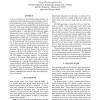Free Online Productivity Tools
i2Speak
i2Symbol
i2OCR
iTex2Img
iWeb2Print
iWeb2Shot
i2Type
iPdf2Split
iPdf2Merge
i2Bopomofo
i2Arabic
i2Style
i2Image
i2PDF
iLatex2Rtf
Sci2ools
115
click to vote
CMMR
2007
Springer
2007
Springer
Understanding Emotion in Raag: An Empirical Study of Listener Responses
A survey of emotion in North Indian classical music was undertaken to determine the type and consistency of emotional responses to raag. Participants listened to five oneminute raag excerpts and recorded their emotional responses after each. They were asked to describe the emotions each excerpt evoked and then to adjust six different sliders indicating the degree to which they felt the following: happy, sad, peaceful, tense, romantic, longing. A total of 280 responses were received. We find that both free-response and quantitative judgments of emotions are significantly different for each raag and quite consistent across listeners. We hypothesized that the primary predictors of emotion in these excerpts would be pitch-class distribution, pitch-class dyad entropy, overall sensory dissonance, and note density. Multiple regression analysis was used to determine the most important factors, their relative importance, and their total predictive value (R2 ). The features in combination ex...
| Added | 07 Jun 2010 |
| Updated | 07 Jun 2010 |
| Type | Conference |
| Year | 2007 |
| Where | CMMR |
| Authors | Parag Chordia, Alex Rae |
Comments (0)

